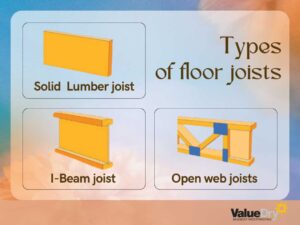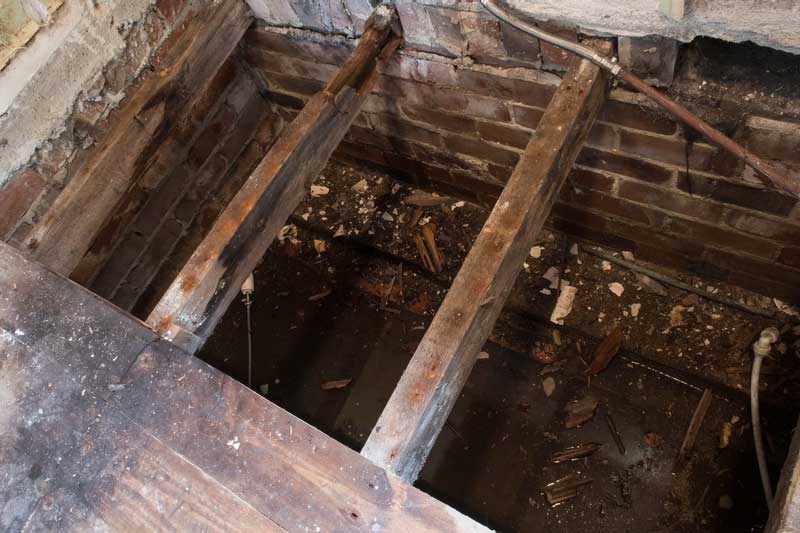How to know if floor joists are bad?
- May 10, 2023
- No Comments
If you’ve ever walked across creaky or uneven flooring, you know how annoying it can be. For homeowners, the feeling is worsened by worrying about a significant problem under the flooring. Your gut tells you something is wrong, but how do you know if floor joists are bad?
Some telltale signs include rotting wood, skewed and unlevel or hard-shutting window frames and doors, sinking crawl space supports, and cracks in interior drywalls.
Let’s look at some of the warning signs and remedies for compromised floor joists.
What are floor joists?
A joist refers to a horizontal component within a structural framework designed to bridge gaps, typically between beams, which then distribute the weight to vertical supports. As an integral element in floor framing systems, joists contribute rigidity to the subfloor sheathing, enabling it to operate as a horizontal stabilizing plane.

There are various types of floor joists, each with its own set of advantages and applications. Some common types include:
- I-beam joists: These are engineered wood joists that resemble the capital letter “I.” Different parts of the ‘I’ are constructed from different materials. For instance, the bottom and top are made from laminated or wood veneer, and the center support is often oriented strand board or plywood.
Overall, they last longer than solid wood and are lighter hence easier to maneuver. However, they aren’t reliable in fires and are a costly option. - Solid lumber joists: These traditional joists are made from trees like Douglas fir. Their span distance is determined by the wood species used, deflection, board size, and spacing, but the maximum distance is 16 feet. Solid lumber joists have been used for centuries and are known for their durability, cost-effectiveness, and load-bearing capacity. However, they can be susceptible to warping, twisting, or shrinking over time, which may require additional maintenance or reinforcement.
- Open web joists: Also known as bar joists or trusses, these joists are prefabricated steel or wood components with a triangular web pattern between the top and bottom chords. This design allows for easy installation of mechanical systems during floor assembly, such as plumbing, electrical, and HVAC. Open web joists are commonly used in commercial and industrial construction due to their high load-bearing capacity and versatility.
Note: Floor joists are necessary for houses built on wood foundations and over basements but not so much for houses built directly on concrete slabs.
What causes bad floor joists?
Rotted floor joists are often caused by moisture exposure, which leads to rot and weakens the wood’s structural integrity, compromising the support provided to the subfloor.
Aside from moisture exposure and water damage, other factors that contribute to the deterioration of floor joists include:
- Improper installation: Incorrectly installed joists can lead to uneven weight distribution and increased stress, causing premature failure.
- Overloading: Excessive weight on the floor from heavy furniture or appliances can strain the joists beyond their capacity, potentially causing damage.
- Insect infestation: Wood-boring insects like termites and carpenter ants can weaken the joists.
- Natural aging: Over time, wood can lose its strength and resilience, making it more susceptible to damage from external factors.
Regular inspection and maintenance are crucial in identifying potential problems and preventing more significant issues to preserve your home’s structural integrity. Some preventive steps include:
- Ensuring proper ventilation and moisture control in crawl spaces and basements. Learn whether it is better to keep crawl space vents open or closed.
- Using moisture-resistant materials in construction, especially in areas prone to dampness.
- Regularly inspecting for signs of insect infestation and addressing them promptly.
- Ensuring that the floor joists and other structural components are correctly installed and adhere to local building codes.
Types of wood rot
Wood rot is broadly categorized into two categories: wet and dry rot. Both are dangerous and lead to serious structural damage to homes.
Wood rot is caused by fungi that break down and consume the cellulose and lignin in wood, weakening its structure and causing decay. The two broad categories are split into white, soft, and brown rot. Each type of rot is characterized by the specific fungi causing it and how it affects the wood.
- White rot: It’s caused by fungi that break down cellulose, hemicellulose, and lignin, resulting in lighter, white, yellow, or grayish-colored spots on the affected wood. The wood becomes springy and bends easily. Over time, the wood becomes too weak and finally snaps under the load. White rot often occurs in hardwoods, such as oak and maple, and can lead to significant structural damage if not addressed promptly.
- Soft rot: Soft rot is caused by fungi that primarily break down cellulose, hemicellulose, and lignin. The affected wood appears discolored and may be soft or spongy. Soft rot progresses slower than other types of wood rot and is more common in wood exposed to high moisture levels for extended periods, such as in damp basements or a crawl space with dirt floor.
- Brown rot: More commonly known as dry rot, brown rot is caused by fungi that primarily break down the cellulose and hemicelluloses in wood. Because it spreads very fast, it’s the most worrying form of rot. The affected wood starts flaking and cracking and might appear burnt in some spots. The wood cracks against the grain and splits as it gets dryer, more brittle, and powdery.
Can bad floor joists be repaired?
Bad floor joists can sometimes be repaired by sistering a new joist alongside the existing one. However, severely damaged joists require removal and replacement, typically accessed through a crawl space.
The option chosen depends on the extent of damage to the structure. The above solutions are implemented as below:
- Sistering: If a floor joist is still structurally sound but shows signs of minor damage or decay, using a sister joist can be an effective repair method. The repair process involves attaching a new joist parallel to the existing one, using construction adhesive and lag bolts or screws to reinforce the original joist and provide additional support. It is crucial to ensure that the new joist is of the same size and material as the existing one to guarantee uniform load distribution.
- Removal and replacement: If a floor joist is significantly damaged and loses its structural support, it must be removed and replaced entirely. This process usually involves accessing the damaged joist through a crawl space or removing the subfloor. It’s essential to properly support the surrounding structure during the replacement process to prevent any further damage or collapse.
Can you replace floor joists without removing the floor?
This is possible by sistering and accessing the joists from the crawl space. However, whether a professional can repair your floor joists without removing the floor depends on the severity of the damage and accessibility.
When addressing damaged floor joists, it’s essential to consider the following:
- Inspect the surrounding joists and subfloor for signs of damage or decay to determine if additional repairs are needed.
- Address the underlying cause of the damage, such as moisture issues or insect infestation, to prevent future problems.
- Consult with professionals at Value Dry Basement Waterproofing to ensure the repair method is appropriate for your specific situation.
Value Dry Basement Waterproofing: Expert crawl space floor joist repairs
Maintaining the structural integrity of your home is crucial, and addressing damaged floor joists is a critical aspect of that process. Whether you need minor repairs through sistering or more extensive work involving crawl space access, working with foundation repair experts is essential.
Value Dry is your comprehensive solution for addressing moisture in a crawl space or basement. Our crawl space encapsulation experts can help you identify and address excess moisture that can lead to structural damage.
Don’t wait until problems escalate; employ crawl space waterproofing solutions today by contacting Value Dry at (888) 339-3063 and give your home the care it deserves.


